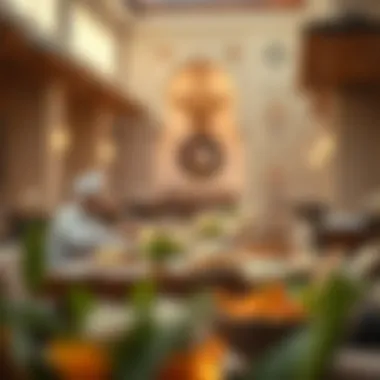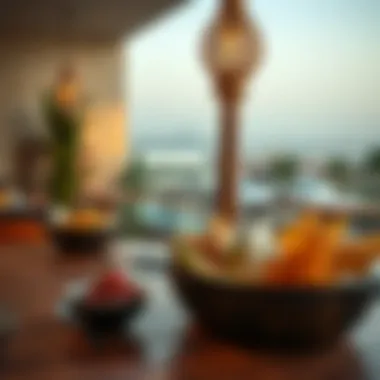Exploring Emirati Cuisine: A Culinary Journey Through the UAE


Intro
Emirati cuisine is like a vibrant tapestry woven from threads of history, culture, and geography. Nestled within the United Arab Emirates, this culinary landscape is a reflection of the region's past – a blend of tradition and modernity. The essence of Emirati food lies in its communal nature, often bringing people together over a shared meal. The dishes tell stories of the desert, the sea, and the rich heritage of the Emirati people.
Every bite is steeped in history, reflecting influences from trading with neighboring cultures and the significance of local ingredients. From the salty embrace of the sea to the arid charms of the desert, the ingredients available dictate the culinary practices followed in the region. As we explore the layers of this cuisine, we will not only uncover traditional recipes but also delve into how contemporary chefs are interpreting these age-old dishes, effectively bridging the gap between the past and the present.
In the pursuit of understanding Emirati food, one engages with the very essence of its society. The significance of hospitality, the art of sharing food, and the deep-seated values tied to these practices emerge as central themes. Join us as we embark on this journey through the heart of the UAE, uncovering the mouthwatering flavors and histories that shape a nation's palette.
Preamble to Emirati Cuisine
Emirati cuisine stands as a vibrant reflection of the country's history, culture, and geographical diversity. Each bite of traditional food tells a story, often reaching back centuries and blending influences from both the land and sea. It's significant to delve into this culinary landscape, as understanding these dishes provides insight not just into flavors but into the very soul of the UAE. Emirati cooking is not merely about satisfying hunger; it's a gateway into the values, practices, and heritage of the Emirati people.
Historical Context
The history of Emirati cuisine is a rich tapestry woven from the threads of trade, migration, and cultural exchange. Spices traveled along ancient trade routes, bringing new flavors and cooking techniques to the region. The earliest inhabitants relied heavily on local ingredients, such as fish from the Arabian Gulf and dates from their palm trees. Over time, various cultural influences, including Persian, Arab, African, and Indian, started to shape what we now recognize as Emirati food. The Bedouins, for instance, contributed a number of traditional cooking styles and dishes that still linger today, many of which focus on simplicity and the use of available resources.
As oil was discovered in the 20th century and the UAE began to flourish economically, so too did its culinary offerings. Restaurants and fast food joints began to dot the landscape, serving dishes from around the world. However, amidst this modernity, traditional meals remain a stronghold in Emirati culture, often served during family gatherings and festivals. This historical continuum illuminates the way food can serve as a cultural artifact, preserving both the memories of a bygone era and adapting to the contemporary landscape.
Cultural Significance
Food in Emirati culture goes beyond being just nourishment. It's a crucial element of social life and is intimately connected to hospitality, family, and tradition. Sharing a meal isn’t merely an act of eating; it’s a ritual of bonding, showing respect, and expressing love. During special occasions such as Eid or weddings, the preparation and sharing of traditional dishes symbolize community and continuity.
Moreover, dishes like Al Harees or Majboos are often the centerpiece of celebrations, embodying both the joy of the occasion and the deep-rooted values of cooperation and sharing. It is common to see large platters of these foods being shared among friends and family, as communal eating strengthens relationships and promotes a sense of belonging.
"Food is a language that speaks to the heart, carrying with it the weight of history and the lightness of joy."
Additionally, the cultural significance of Emirati dishes extends to rituals and customs. It is not uncommon for families to gather during Ramadan to break their fast with traditional meals, reinforcing bonds and marking the sanctity of the month. In this manner, food serves as both a connection to the past and a way to navigate the present, making it indispensable to the Emirati identity.
Thus, Emirati cuisine is replete with rich tales, reflecting both individual and collective experiences. It offers insights into the evolving narrative of the UAE and provides newcomers and visitors with a flavorful entry point into its complex society. Understanding this cuisine can yield a greater appreciation for the Emirati way of life and deepen connections within this dynamic and multifaceted environment.
Key Ingredients in Emirati Cooking
Understanding the essence of Emirati cuisine begins with its ingredients. This section shines a spotlight on the vital components that go into making dishes unique. Each ingredient not only adds flavor but also tells a tale of the land, reflecting the geography, climate, and cultural interactions over centuries. In the UAE, where arid deserts meet the azure sea, the ingredients draw their significance from both these contrasting worlds, leading to a spectacular culinary tapestry.
Spices and Herbs
Emirati cooking is a melange of flavors, mostly attributed to the generous use of spices and herbs. Traditional dishes are often seasoned with mixtures like berbere, za'atar, and saffron. Saffron, imported at great cost in the past, now finds a prominent place in dishes like Majboos, elevating the taste and serving as a status symbol.
Spices do not just flavor food; they also preserve it, a vital consideration in a hot climate. The key spices include:
- Cumin: Adds earthiness and depth.
- Cardamom: Lends a sweet warmth, often used in coffee.
- Cloves: Imparts a potent aroma, ideal for meat dishes.
- Turmeric: Provides a vibrant color and is known for its health benefits.
Herbs, such as fresh coriander and parsley, complement the spices and are often used as garnishes, contributing freshness and texture. This balancing act of spices and herbs mirrors the multicultural influences of the UAE, where trade routes have historically mixed flavors from diverse origins.
Meat and Seafood
Meat and seafood play pivotal roles in the Emirati diet. Initially, the availability of ingredients heavily dictated what could be used, leading to the widespread consumption of lamb and chicken as staple proteins. Lamb, particularly in dishes like Al Harees, is slow-cooked until tender; this method ensures rich flavors permeate throughout.


The proximity of the sea means that seafood is also abundant. Locally caught fish like hamour and shrimp frequently grace the dining table. Grilled fish, marinated in bold spices, serves as a testament to the UAE's thriving maritime culture. The use of fish encompasses both the everyday and the festive, making it essential in various celebrations.
Grains and Legumes
When looking at staples, grains and legumes form the backbone of the cuisine. Rice is the most prominent grain, often served alongside meat in dishes like Majboos. Often spiced, the rice absorbs the flavors of meats and spices, creating a cohesive dish that lingers on the palate.
Legumes, including lentils and chickpeas, are rich in protein and serve both health and culinary purposes. These ingredients link back to diverse agricultural practices from regions where pulses are grown, representing the resourcefulness of Emirati cooking. For instance, ful medames, made from fava beans, appears on breakfast tables, showcasing how legumes have integrated themselves into daily life.
Fruits and Vegetables
The arid climate of the UAE poses a challenge for agriculture, yet the variety of fruits and vegetables that thrive here is remarkable. Date palms, ideally suited for the desert environment, are symbolic in Emirati culture. They provide a natural sweetness and appear in various forms, from fresh dates to syrup used in desserts.
Vegetables like squash, eggplant, and green pepppers often find their way into stews and salads. Local farmers market these fresh produce, underscoring the significance of farm-to-table practices in the UAE's culinary landscape.
"The selection of ingredients is a narrative of resilience and adaptation."
Traditional Emirati Dishes
Traditional Emirati dishes are the beating heart of the country's culinary identity. These meals reflect a rich tapestry woven through centuries, representing the heritage of the UAE and the communal joy of shared feasting. Within this section, the focus is on the hallmark dishes that not only gratify the palate but also tell stories of culture and tradition. Traditional meals often celebrate gatherings, be it family events or festive occasions. It's fascinating to note that many of these dishes are prepared with love and communal effort, making every bite a shared experience, bringing families and friends closer.
Al Harees
Al Harees, a dish that has stood the test of time, is a comfort food for many Emiratis. This delicacy consists primarily of wheat and meat, traditionally prepared during special occasions such as Ramadan and weddings. The method of cooking involved in making Al Harees is labor-intensive yet simple, with the grains being cooked slowly in water until they become a smooth paste, then mixed with meat. This dish signifies unity because it is often prepared in large quantities, served during communal celebrations, showcasing the hospitality of the Emirati people. The taste is mild yet satisfying, with a texture that's creamy and inviting.
Shawarma and Kebab Variants
Shawarma and kebabs are street food staples in Emirati cuisine, adored not just by locals but also by tourists. Shawarma is typically made from marinated meat, often chicken or lamb, that is roasted and served in pita bread with a variety of toppings and sauces. Each vendor has their twist, making a simple meal an adventure in flavor. Kebab variants, whether grilled or cooked in a rich sauce, highlight the diverse methods of preparation present in the UAE. They often come marshalled with fragrant rice and vegetables, reinforcing the emphasis on balanced and vibrant flavors. These dishes have become so intertwined with Emirati culture that it's hard to imagine the culinary landscape without them.
Majboos: The Signature Rice Dish
Majboos stands out as the signature rice dish of Emirati cuisine, often referred to as the pride of the table. The dish is characterized by spiced rice, succulent meat, and bursts of flavor from added spices. It is a festive dish often prepared for gatherings, showcasing the artistry of Emirati cooking. The rice is simmered in a flavorful broth, absorbing the richness from the meat while being seasoned meticulously. This hearty dish represents not just sustenance but also an embodiment of Emirati tradition, as it brings friends and family together, reflecting communal values. Majboos has numerous regional interpretations, further emphasizing the idea of shared culture through food.
Stuffed Camels and Other Extravagances
While it may seem exceedingly extravagant, stuffed camels represent a pinnacle of communal cooking in Emirati culture, often prepared for significant celebrations such as weddings or national holidays. This unique dish is a feat of culinary engineering, requiring careful planning and execution. Typically, the camel is stuffed with various ingredients, including spices, rice, and even other smaller birds. Not only does this dish blow the mind with its scale, but it also underscores the generosity and hospitality of EMirati society. Such extravagances are not merely about food; they symbolize wealth, celebration, and the importance of sharing bounty with loved ones. In addition to stuffed camels, other lavish dishes such as seafood platters or extravagant rice dishes reinforce a sense of pride in the culinary arts of the UAE.
"Food in the UAE is more than just sustenance; it's a language of love and tradition that transcends generations."
Remember, embracing traditional Emirati dishes opens up a world of flavors and shared stories, making every meal a cherished memory.
Cooking Techniques in Emirati Cuisine
Emirati cuisine is marked by its unique cooking practices which serve as a testament to the resourcefulness and culture of the people. Each technique employed not only brings out the rich flavors of the ingredients but also plays a critical role in preserving traditions that date back generations. Understanding these methods gives insight into how Emirati food reflects its heritage and regional influences. Let’s take a closer look at some of the key cooking techniques that define this vibrant cuisine.
Slow Cooking Methods
Slow cooking is a cornerstone in Emirati culinary practices, often employed to enhance the flavors and tenderness of various ingredients, especially meats. This technique allows spices and herbs to intermingle fully, creating a depth of flavors that cannot be achieved through quicker methods.


For instance, Al Harees, a traditional dish made with wheat and meat, requires hours on low heat to soften the wheat and meld the flavors together. This patient process is not just about cooking; it's also about gathering family and friends around the stove, fostering relationships and community spirit.
Some benefits include:
- Flavor Enhancement: The extended cooking time allows for layers of flavor to develop.
- Tenderization: Meats, particularly tougher cuts, become melt-in-your-mouth tender.
- Nutritional Preservation: Long, slow cooking can retain nutritional value, especially when using fresh ingredients.
Grilling and Barbecue Styles
Grilling holds a special place in the heart of Emirati cooking, particularly during social gatherings. The warmth of the grill symbolizes hospitality, as it often brings family and friends together. Pieces of marinated meat, fish, or chicken are cooked over an open flame, infusing the dishes with a smoky flavor that's hard to replicate.
One notable dish that showcases this technique is the various kebabs found throughout the UAE. Each region may offer its own twist, whether it's a blend of spices or the method of preparation.
Key elements of Emirati grilling include:
- Marination: Often using local spices and yogurt to tenderize and flavor the meat before grilling.
- Social Aspect: Grilling is often done outdoors, making it a communal activity.
- Variety: From shrimp to lamb, the grilling possibilities are near endless, showcasing local ingredients and preferences.
Frying: A Popular Technique
Frying is another common method in Emirati cuisine, often used for preparing snacks or side dishes that are crispy and delicious. Dishes like Samboosa (stuffed pastries) exemplify this technique. Quickly frying results in a delicate crispy exterior, which contrasts delightfully with the flavorful fillings inside.
Frying allows for:
- Quick Preparation: Ideal for snacks or appetizers when time is of the essence.
- Texture Variety: Provides a contrasting texture that adds an enjoyable crunch to dishes.
- Flavor Enhancement: The frying process can develop rich, complex tastes, enhancing overall enjoyment.
Ultimately, the cooking techniques employed in Emirati cuisine are so much more than methods; they are a reflection of a culture that values flavor, community, and tradition. As we move towards a modern interpretation of these age-old cooking practices, the essence of Emirati food continues to thrive, showcasing the adaptability and rich culinary heritage of the region.
Regional Variations of Emirati Cuisine
Understanding the regional variations of Emirati cuisine is vital as it uncovers the diverse culinary identity within the UAE. Each emirate showcases a distinctive flavor profile shaped by its local resources, trade relationships, and cultural interactions over the years. From street vendors in bustling Dubai to family-run establishments in Sharjah, these regional specialties reflect the richness of the Emirati culinary landscape. Moreover, the blend of traditional recipes and modern interpretations illustrates the adaptability of this cuisine, making it relevant in today’s fast-paced world. Recognizing these variations also highlights the significance of local pride in food, as each dish tells the story of its community and history.
Dubai's Culinary Scene
Dubai stands as the centerpiece of culinary innovation in the UAE. The city is an amalgamation of flavors and influences, boasting a melting pot of culinary traditions from around the globe. While traditional dishes like Al Harees are celebrated, the city has also embraced international fast food chains and global cuisines, making it a hot spot for food enthusiasts. There's no shortage of luxurious dining experiences here, from Michelin-starred restaurants to humble street food stalls.
Notable culinary landmarks, such as the Dubai Food Festival, showcase everything from traditional Emirati flavors to fusion dishes that combine local and international cuisine. Furthermore, districts like Old Dubai keep traditional practices alive, where you can savor meals made using age-old recipes passed down through generations, all while surrounded by historic architecture.
Abu Dhabi's Influence
As the capital city, Abu Dhabi reflects a strong connection to traditional Emirati culture. The cuisine here often emphasizes the use of local ingredients, especially fresh seafood and spices common to the region. This emirate tends to keep its culinary traditions more intact than Dubai, although modern influences are evident.
In places like the Corniche, you can find eateries serving dishes like Majboos and Ghuzi that reflect the essence of Emirati hospitality. Besides the local offerings, Abu Dhabi hosts international chefs who experiment with Emirati ingredients, thus creating a unique bridge between heritage and innovation.
Sharjah and its Unique Flavors
Sharjah is often considered a treasure trove for culinary exploration. Unlike its flamboyant neighbors, Sharjah offers an authentic glimpse into traditional Emirati life and cuisine. Here, street food stalls are abundant, serving grilled meats, falafel, and rice dishes that hold true to Emirati roots.
A visit to the Al Qasba canal reveals local favorites that are deeply entrenched in the Emirati culture. Furthermore, Sharjah places a strong emphasis on agriculture, meaning that fresh vegetables and herbs often find their way into dishes. The emirate’s unique flavors tell a story of its own, influenced by both Bedouin lifestyle and the coastal fishing heritage prevalent in many communities.


Ras Al Khaimah's Traditional Offerings
Ras Al Khaimah, known for its rugged mountains and serene beaches, has a culinary scene that is as varied as its landscape. Here, traditional dishes are inspired by both land and sea. For example, Ras Al Khaimah’s fish dishes are heavily influenced by the local catch, bringing to life flavors that encapsulate the essence of coastal living.
The emirate is also famous for its use of date palms, where dishes often incorporate date paste or syrup to enhance sweetness. Local stews and grains are also common, making hearty meals ideal for gatherings and special occasions. At a traditional Emirati meal in Ras Al Khaimah, you're likely to enjoy the freshest ingredients, prepared with care and served with a generous portion of hospitality.
"Each plate of Emirati food tells a story beyond its flavor, reflecting the history, tradition, and cultural essence unique to its region."
Emirati Cuisine in Contemporary Dining
Emirati cuisine holds a significant place in the landscape of contemporary dining, evolving with the times while retaining its rich cultural roots. The dining experience in the UAE reflects a blend of tradition and modernity, showcasing how ancient culinary practices can adapt to current trends. This section will explore the critical features of Emirati cuisine in today's dining scene, from fusion trends to the vibrant street food culture and the appeal of dining experiences for tourists.
Fusion Cuisine Trends
The modern Emirati food scene is vibrant with experimentation, where traditional recipes meet international flavors. This fusion is not just a culinary trend but also a testament to the country’s diverse population. Chefs are creatively combining local spices with global ingredients, resulting in dishes that are both familiar and new. For instance, you might find a chicken shawarma burger topped with spicy harissa mayo, or a saffron-infused risotto that pays homage to the traditional rice dishes of the Emirates.
The beauty of fusion cuisine lies in its ability to introduce Emirati flavors to the broader food-loving public. It creates an inviting atmosphere where locals and tourists alike can appreciate the essence of Emirati cooking while playing with new tastes. This creative culinary adaptation shows a willingness to innovate while respecting the past, fostering a greater understanding of Emirati culture.
Street Food Culture
Street food is an essential element of the UAE’s contemporary dining scene, echoing the communal spirit of Emirati life. Streets and food markets buzz with activity as vendors serve up quick bites that delight both residents and visitors. Dishes such as falafel wraps, kebabs, and samosas can often be found at these vibrant stalls, highlighting the fusion of flavors that characterize the region.
Street food in the UAE is not merely about nourishment; it’s an experience that connects people. From bustling markets to food trucks, these spaces encourage sharing and community. The savory smells of grilled meats and sweet pastries fill the air as family and friends gather to enjoy their meals together. Street food encompasses the lively energy of the UAE and showcases its culinary diversity, adapting to trends without losing sight of tradition.
Tourist Attractions and Dining
Tourists visiting the UAE often embark on culinary adventures, seeking out unique dining experiences that reflect the richness of Emirati cuisine. High-end restaurants coexist with traditional eateries, creating a dining landscape that offers something for everyone. Places like Al Fanar, which recreates old Dubai dining experiences, invite guests to savor local flavors in authentic settings.
Tourist attractions often feature culinary tours that immerse visitors in Emirati food culture. Whether it’s cooking classes that teach how to prepare dishes like majboos or dining under the stars in the desert, these experiences cater to those eager to learn about local traditions. Dining out in the UAE is about storytelling, with restaurants oftentimes highlighting their connection to Emirati heritage, culinary customs, and regional specialties.
"The future of Emirati cuisine lies not just in preserving the past but in embracing the flavors from around the world."
This sentiment resonates well in the contemporary dining scene. As the UAE continues to develop as a culinary hub, the potential for innovative eating experiences grows, ensuring that Emirati cuisine remains relevant and vibrant.
Culmination: The Future of Emirati Cuisine
As we reflect on the culinary journey through the UAE, it becomes clear that the future of Emirati cuisine is poised for a remarkable evolution. The interplay of tradition and modernity is essential to understanding this culinary landscape. Integration of innovative dining concepts alongside a profound respect for heritage is vital. The importance of this balance cannot be overstated, as it preserves the essence of a culture while simultaneously inviting new influences that broaden palates and culinary horizons.
Preservation of Culinary Heritage
The preservation of culinary heritage stands as a foundational pillar in the ongoing evolution of Emirati cuisine. With rapid globalization and the influx of diverse cultures into the UAE, there’s a burgeoning risk that traditional recipes, methods, and values might fade into obscurity. Efforts are currently underway to safeguard these culinary treasures. This includes initiatives aimed at documenting traditional recipes and fostering communities that share knowledge across generations.
Community gatherings, often centered around meal preparation, represent not only an opportunity to enjoy classic dishes but also a crucial mechanism for passing down culinary skills and stories. Such communal practices ensure that the flavors of dishes like Al Harees or Majboos are preserved, enriching the cultural fabric of the UAE.
One notable effort is the establishment of culinary schools and workshops that teach both locals and expatriates the authentic methods of Emirati cooking. Through these avenues, the intricate balance of spices and cooking techniques is shared, giving new life to age-old traditions.
"Food is the memory of a culture. To lose a recipe is to lose a little piece of your history."
Evolving Palates
As Emirati cuisine embraces its future, it is essential to note the role of evolving palates in shaping this culinary identity. Today’s diners are more adventurous than ever, eager to explore a fascinating blend of flavors. The infusion of global culinary trends into traditional recipes reflects a broader shift in consumer expectations.
For instance, contemporary chefs are experimenting with fusion cuisine by incorporating elements from various cultures, be it Asian spices or Western cooking techniques. Food trucks and casual eateries popularize these fusions, making them accessible to a broader audience.
Moreover, health consciousness among diners is influencing the types of ingredients used in traditional dishes. A push towards sustainability and organic sourcing has led to many chefs rethinking the fundamental recipes, adapting them to meet modern dietary preferences without losing their culinary integrity.
The adaptability of Emirati cuisine, alongside its rich history, positions it uniquely within the global culinary arena. As the lines between traditional and contemporary blur, the future looks bright, inviting both locals and international visitors to savor the depths of the Emirati culinary experience.











